Ethics and Corporate Social Responsibility Report: H&M Analysis
VerifiedAdded on 2020/05/28
|6
|1262
|165
Report
AI Summary
This report provides an in-depth analysis of H&M's Corporate Social Responsibility (CSR) practices. It begins with a company profile, highlighting H&M's global presence and diverse product portfolio. The report then examines H&M's approach to sustainability, including its use of renewable energy, waste reduction, and supplier relations. A stakeholder analysis identifies key groups, such as government, media, customers, and employees, and assesses their power and interest. The report then applies Blackburn's sustainability model, evaluating H&M's environmental and social initiatives, including its partnerships and employee welfare programs. A critical evaluation assesses H&M's performance against GRI guidelines, considering content, completeness, balance, and independent auditing. The analysis highlights strengths such as renewable energy use and weaknesses like the absence of ISO certification and limited control over labor welfare. The report concludes with a discussion of the implications of H&M's CSR efforts.
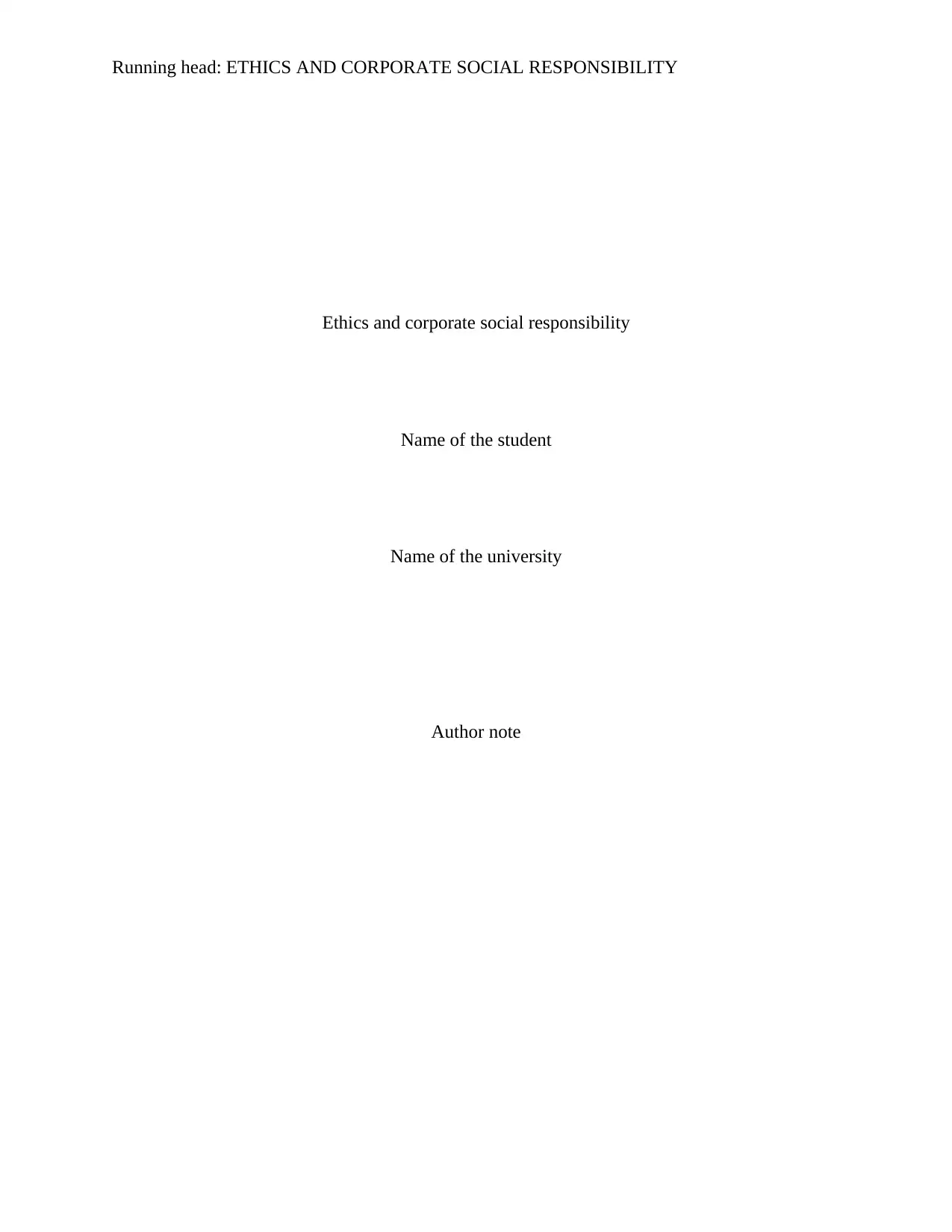
Running head: ETHICS AND CORPORATE SOCIAL RESPONSIBILITY
Ethics and corporate social responsibility
Name of the student
Name of the university
Author note
Ethics and corporate social responsibility
Name of the student
Name of the university
Author note
Paraphrase This Document
Need a fresh take? Get an instant paraphrase of this document with our AI Paraphraser
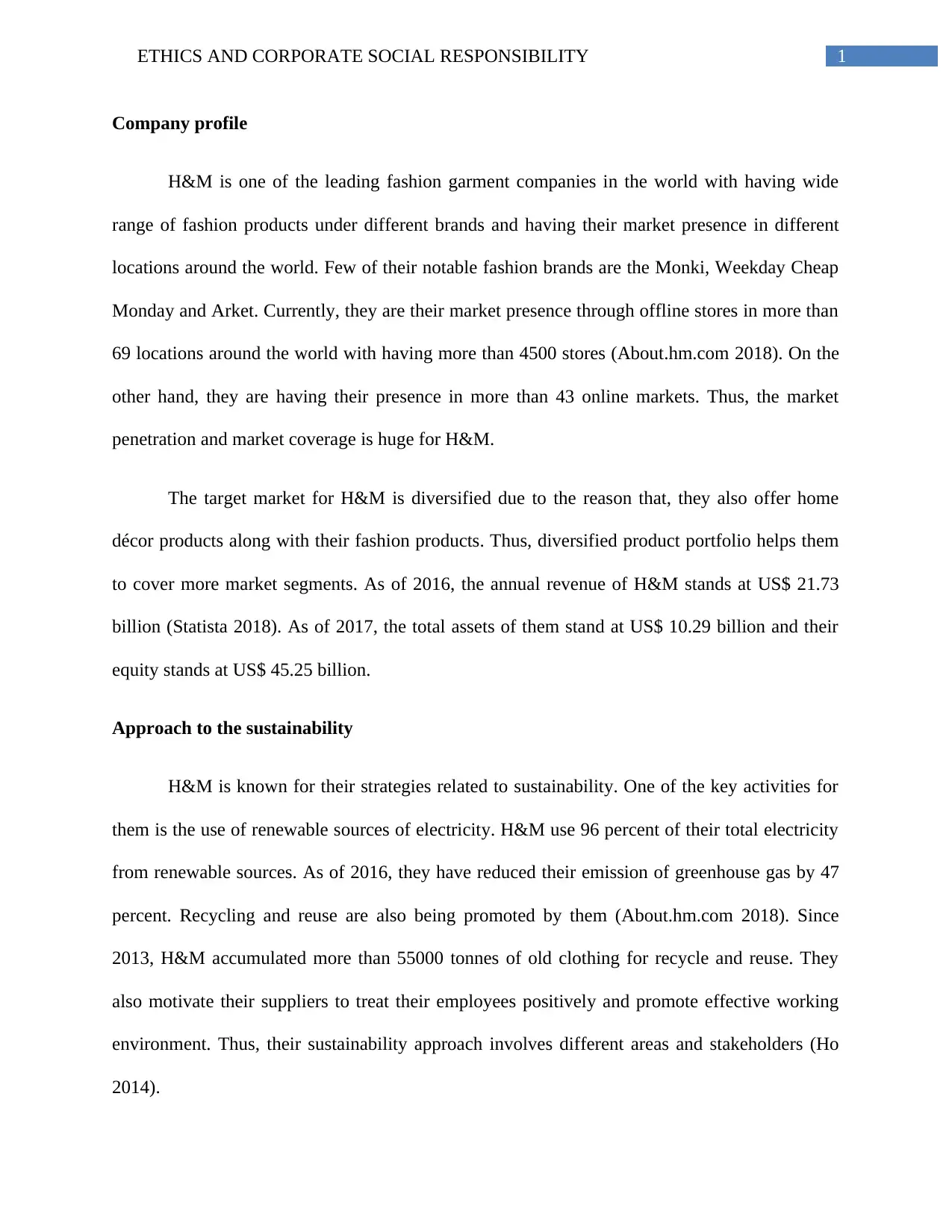
1ETHICS AND CORPORATE SOCIAL RESPONSIBILITY
Company profile
H&M is one of the leading fashion garment companies in the world with having wide
range of fashion products under different brands and having their market presence in different
locations around the world. Few of their notable fashion brands are the Monki, Weekday Cheap
Monday and Arket. Currently, they are their market presence through offline stores in more than
69 locations around the world with having more than 4500 stores (About.hm.com 2018). On the
other hand, they are having their presence in more than 43 online markets. Thus, the market
penetration and market coverage is huge for H&M.
The target market for H&M is diversified due to the reason that, they also offer home
décor products along with their fashion products. Thus, diversified product portfolio helps them
to cover more market segments. As of 2016, the annual revenue of H&M stands at US$ 21.73
billion (Statista 2018). As of 2017, the total assets of them stand at US$ 10.29 billion and their
equity stands at US$ 45.25 billion.
Approach to the sustainability
H&M is known for their strategies related to sustainability. One of the key activities for
them is the use of renewable sources of electricity. H&M use 96 percent of their total electricity
from renewable sources. As of 2016, they have reduced their emission of greenhouse gas by 47
percent. Recycling and reuse are also being promoted by them (About.hm.com 2018). Since
2013, H&M accumulated more than 55000 tonnes of old clothing for recycle and reuse. They
also motivate their suppliers to treat their employees positively and promote effective working
environment. Thus, their sustainability approach involves different areas and stakeholders (Ho
2014).
Company profile
H&M is one of the leading fashion garment companies in the world with having wide
range of fashion products under different brands and having their market presence in different
locations around the world. Few of their notable fashion brands are the Monki, Weekday Cheap
Monday and Arket. Currently, they are their market presence through offline stores in more than
69 locations around the world with having more than 4500 stores (About.hm.com 2018). On the
other hand, they are having their presence in more than 43 online markets. Thus, the market
penetration and market coverage is huge for H&M.
The target market for H&M is diversified due to the reason that, they also offer home
décor products along with their fashion products. Thus, diversified product portfolio helps them
to cover more market segments. As of 2016, the annual revenue of H&M stands at US$ 21.73
billion (Statista 2018). As of 2017, the total assets of them stand at US$ 10.29 billion and their
equity stands at US$ 45.25 billion.
Approach to the sustainability
H&M is known for their strategies related to sustainability. One of the key activities for
them is the use of renewable sources of electricity. H&M use 96 percent of their total electricity
from renewable sources. As of 2016, they have reduced their emission of greenhouse gas by 47
percent. Recycling and reuse are also being promoted by them (About.hm.com 2018). Since
2013, H&M accumulated more than 55000 tonnes of old clothing for recycle and reuse. They
also motivate their suppliers to treat their employees positively and promote effective working
environment. Thus, their sustainability approach involves different areas and stakeholders (Ho
2014).
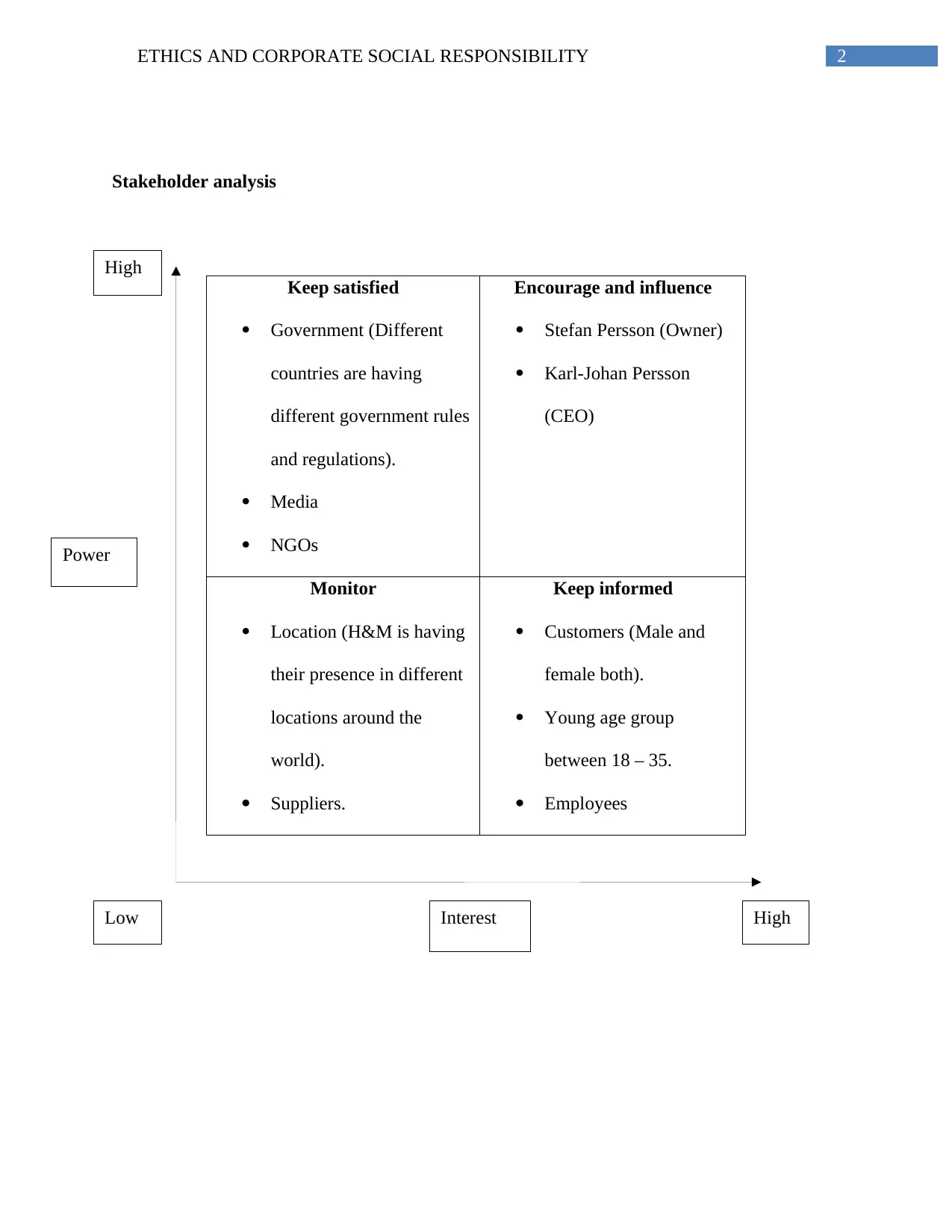
2ETHICS AND CORPORATE SOCIAL RESPONSIBILITY
High
Low High
Power
Interest
Stakeholder analysis
Keep satisfied
Government (Different
countries are having
different government rules
and regulations).
Media
NGOs
Encourage and influence
Stefan Persson (Owner)
Karl-Johan Persson
(CEO)
Monitor
Location (H&M is having
their presence in different
locations around the
world).
Suppliers.
Keep informed
Customers (Male and
female both).
Young age group
between 18 – 35.
Employees
High
Low High
Power
Interest
Stakeholder analysis
Keep satisfied
Government (Different
countries are having
different government rules
and regulations).
Media
NGOs
Encourage and influence
Stefan Persson (Owner)
Karl-Johan Persson
(CEO)
Monitor
Location (H&M is having
their presence in different
locations around the
world).
Suppliers.
Keep informed
Customers (Male and
female both).
Young age group
between 18 – 35.
Employees
⊘ This is a preview!⊘
Do you want full access?
Subscribe today to unlock all pages.

Trusted by 1+ million students worldwide
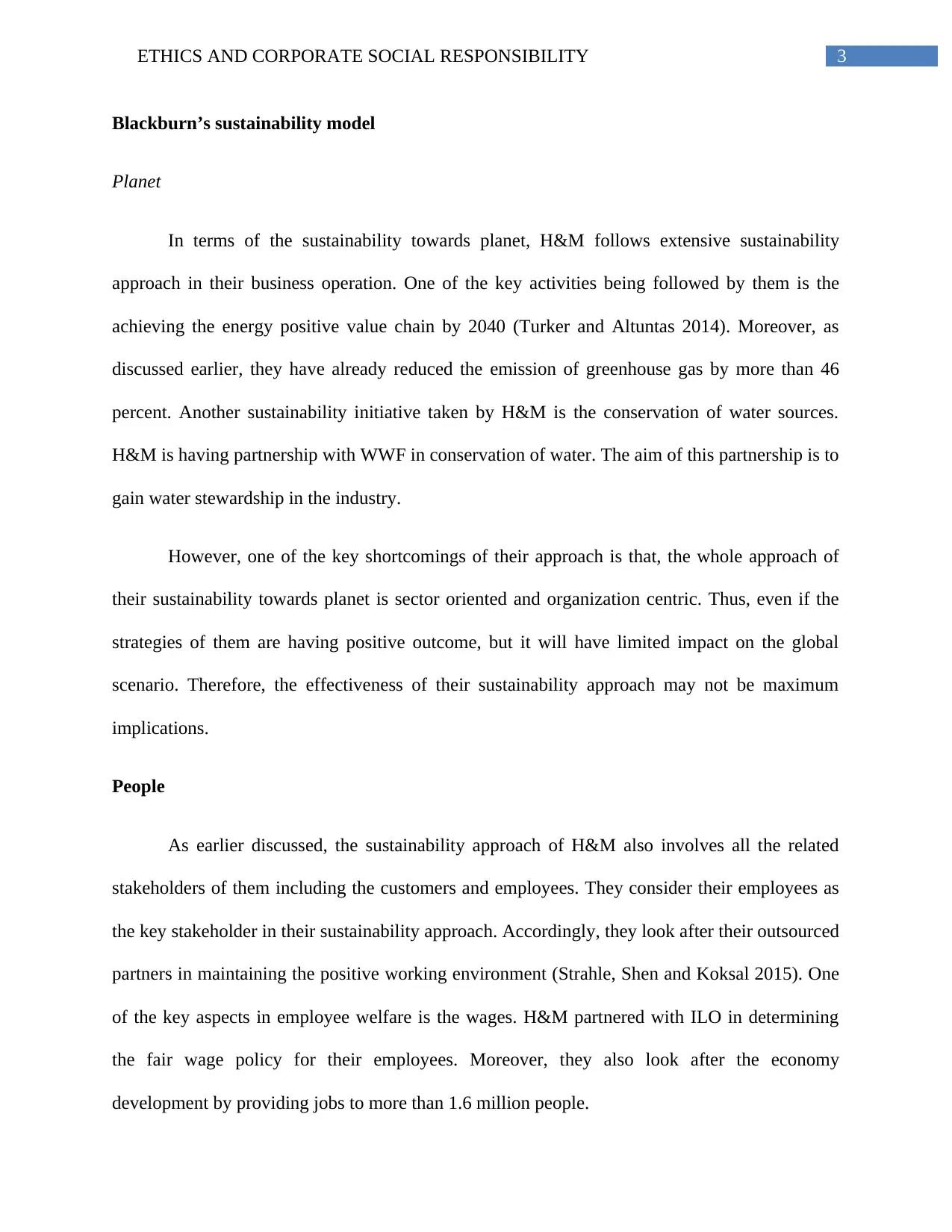
3ETHICS AND CORPORATE SOCIAL RESPONSIBILITY
Blackburn’s sustainability model
Planet
In terms of the sustainability towards planet, H&M follows extensive sustainability
approach in their business operation. One of the key activities being followed by them is the
achieving the energy positive value chain by 2040 (Turker and Altuntas 2014). Moreover, as
discussed earlier, they have already reduced the emission of greenhouse gas by more than 46
percent. Another sustainability initiative taken by H&M is the conservation of water sources.
H&M is having partnership with WWF in conservation of water. The aim of this partnership is to
gain water stewardship in the industry.
However, one of the key shortcomings of their approach is that, the whole approach of
their sustainability towards planet is sector oriented and organization centric. Thus, even if the
strategies of them are having positive outcome, but it will have limited impact on the global
scenario. Therefore, the effectiveness of their sustainability approach may not be maximum
implications.
People
As earlier discussed, the sustainability approach of H&M also involves all the related
stakeholders of them including the customers and employees. They consider their employees as
the key stakeholder in their sustainability approach. Accordingly, they look after their outsourced
partners in maintaining the positive working environment (Strahle, Shen and Koksal 2015). One
of the key aspects in employee welfare is the wages. H&M partnered with ILO in determining
the fair wage policy for their employees. Moreover, they also look after the economy
development by providing jobs to more than 1.6 million people.
Blackburn’s sustainability model
Planet
In terms of the sustainability towards planet, H&M follows extensive sustainability
approach in their business operation. One of the key activities being followed by them is the
achieving the energy positive value chain by 2040 (Turker and Altuntas 2014). Moreover, as
discussed earlier, they have already reduced the emission of greenhouse gas by more than 46
percent. Another sustainability initiative taken by H&M is the conservation of water sources.
H&M is having partnership with WWF in conservation of water. The aim of this partnership is to
gain water stewardship in the industry.
However, one of the key shortcomings of their approach is that, the whole approach of
their sustainability towards planet is sector oriented and organization centric. Thus, even if the
strategies of them are having positive outcome, but it will have limited impact on the global
scenario. Therefore, the effectiveness of their sustainability approach may not be maximum
implications.
People
As earlier discussed, the sustainability approach of H&M also involves all the related
stakeholders of them including the customers and employees. They consider their employees as
the key stakeholder in their sustainability approach. Accordingly, they look after their outsourced
partners in maintaining the positive working environment (Strahle, Shen and Koksal 2015). One
of the key aspects in employee welfare is the wages. H&M partnered with ILO in determining
the fair wage policy for their employees. Moreover, they also look after the economy
development by providing jobs to more than 1.6 million people.
Paraphrase This Document
Need a fresh take? Get an instant paraphrase of this document with our AI Paraphraser
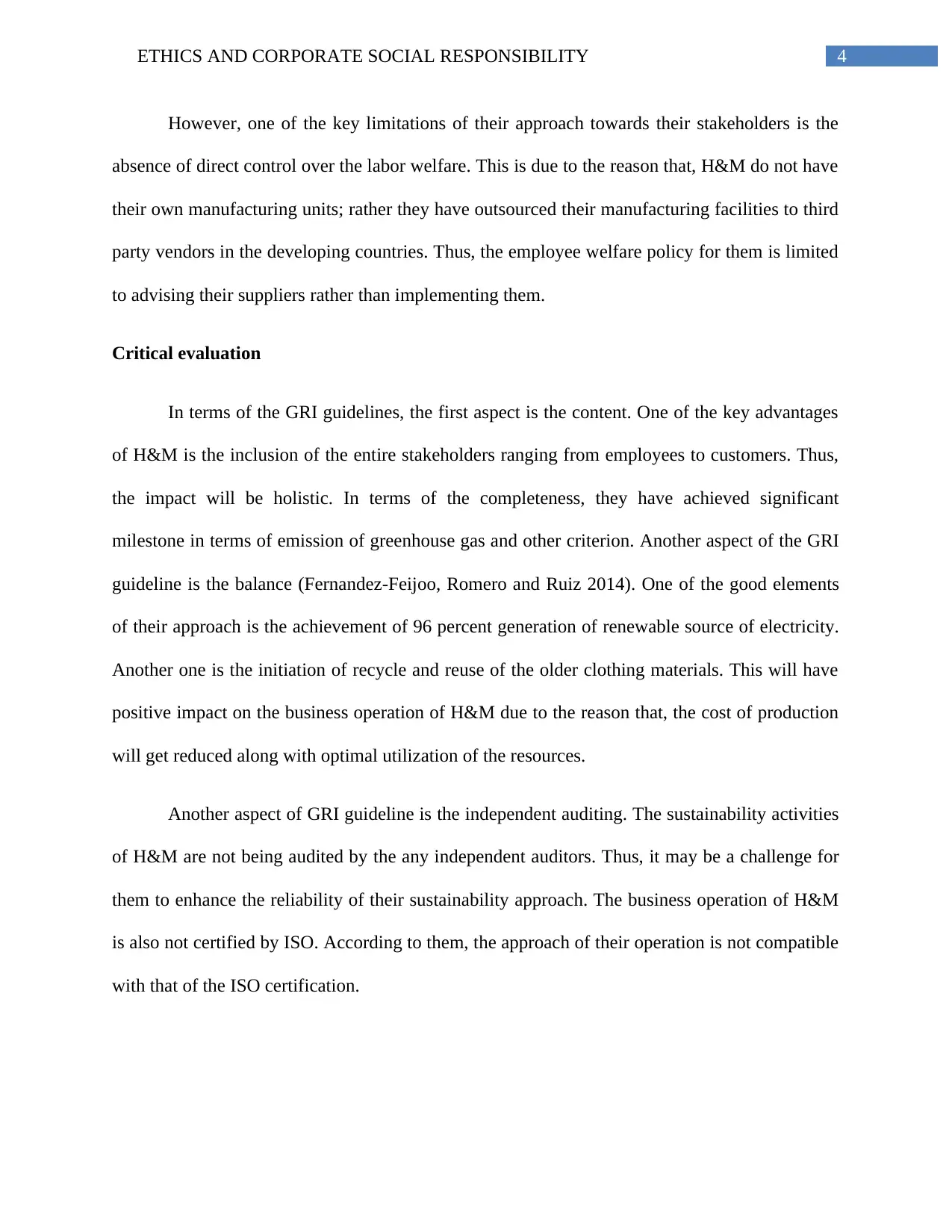
4ETHICS AND CORPORATE SOCIAL RESPONSIBILITY
However, one of the key limitations of their approach towards their stakeholders is the
absence of direct control over the labor welfare. This is due to the reason that, H&M do not have
their own manufacturing units; rather they have outsourced their manufacturing facilities to third
party vendors in the developing countries. Thus, the employee welfare policy for them is limited
to advising their suppliers rather than implementing them.
Critical evaluation
In terms of the GRI guidelines, the first aspect is the content. One of the key advantages
of H&M is the inclusion of the entire stakeholders ranging from employees to customers. Thus,
the impact will be holistic. In terms of the completeness, they have achieved significant
milestone in terms of emission of greenhouse gas and other criterion. Another aspect of the GRI
guideline is the balance (Fernandez-Feijoo, Romero and Ruiz 2014). One of the good elements
of their approach is the achievement of 96 percent generation of renewable source of electricity.
Another one is the initiation of recycle and reuse of the older clothing materials. This will have
positive impact on the business operation of H&M due to the reason that, the cost of production
will get reduced along with optimal utilization of the resources.
Another aspect of GRI guideline is the independent auditing. The sustainability activities
of H&M are not being audited by the any independent auditors. Thus, it may be a challenge for
them to enhance the reliability of their sustainability approach. The business operation of H&M
is also not certified by ISO. According to them, the approach of their operation is not compatible
with that of the ISO certification.
However, one of the key limitations of their approach towards their stakeholders is the
absence of direct control over the labor welfare. This is due to the reason that, H&M do not have
their own manufacturing units; rather they have outsourced their manufacturing facilities to third
party vendors in the developing countries. Thus, the employee welfare policy for them is limited
to advising their suppliers rather than implementing them.
Critical evaluation
In terms of the GRI guidelines, the first aspect is the content. One of the key advantages
of H&M is the inclusion of the entire stakeholders ranging from employees to customers. Thus,
the impact will be holistic. In terms of the completeness, they have achieved significant
milestone in terms of emission of greenhouse gas and other criterion. Another aspect of the GRI
guideline is the balance (Fernandez-Feijoo, Romero and Ruiz 2014). One of the good elements
of their approach is the achievement of 96 percent generation of renewable source of electricity.
Another one is the initiation of recycle and reuse of the older clothing materials. This will have
positive impact on the business operation of H&M due to the reason that, the cost of production
will get reduced along with optimal utilization of the resources.
Another aspect of GRI guideline is the independent auditing. The sustainability activities
of H&M are not being audited by the any independent auditors. Thus, it may be a challenge for
them to enhance the reliability of their sustainability approach. The business operation of H&M
is also not certified by ISO. According to them, the approach of their operation is not compatible
with that of the ISO certification.
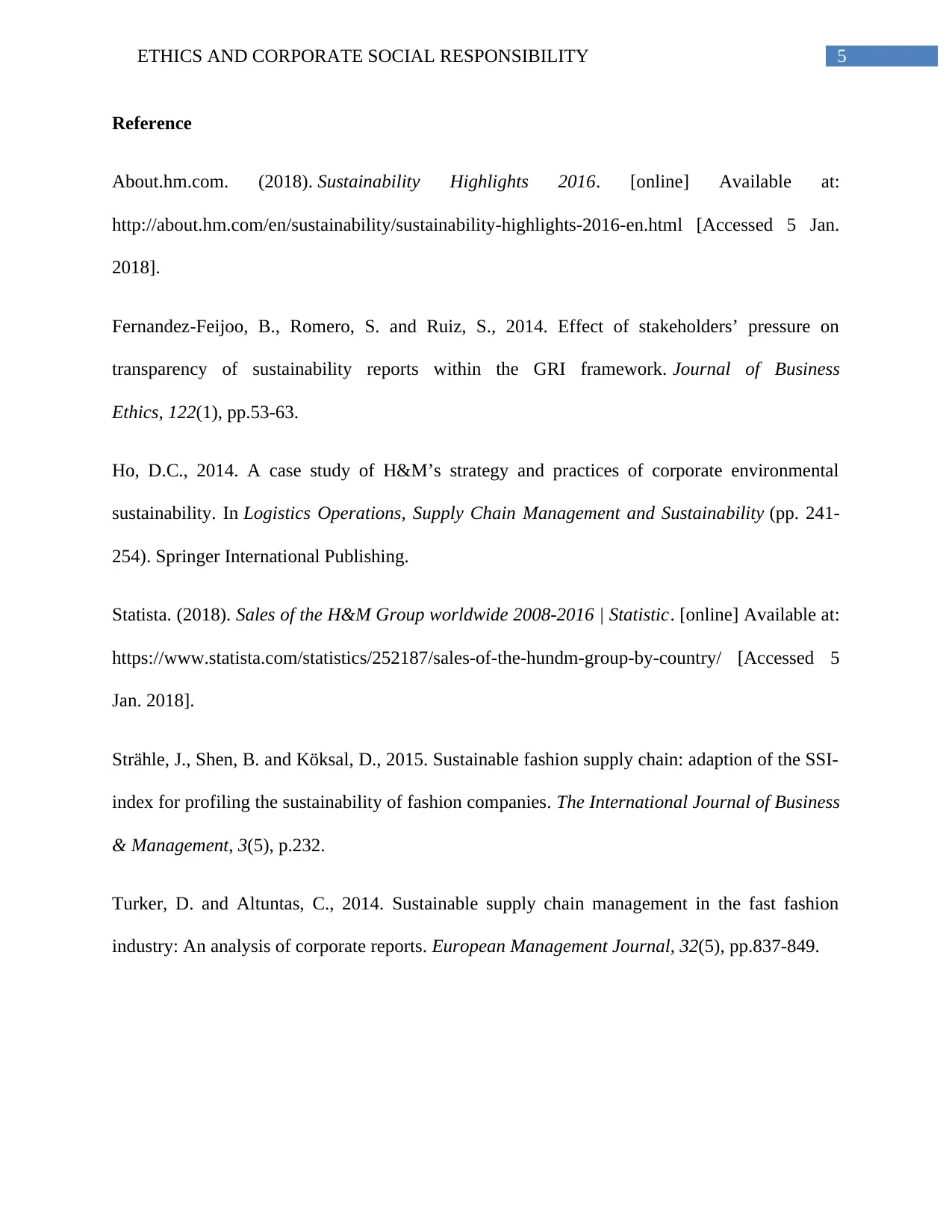
5ETHICS AND CORPORATE SOCIAL RESPONSIBILITY
Reference
About.hm.com. (2018). Sustainability Highlights 2016. [online] Available at:
http://about.hm.com/en/sustainability/sustainability-highlights-2016-en.html [Accessed 5 Jan.
2018].
Fernandez-Feijoo, B., Romero, S. and Ruiz, S., 2014. Effect of stakeholders’ pressure on
transparency of sustainability reports within the GRI framework. Journal of Business
Ethics, 122(1), pp.53-63.
Ho, D.C., 2014. A case study of H&M’s strategy and practices of corporate environmental
sustainability. In Logistics Operations, Supply Chain Management and Sustainability (pp. 241-
254). Springer International Publishing.
Statista. (2018). Sales of the H&M Group worldwide 2008-2016 | Statistic. [online] Available at:
https://www.statista.com/statistics/252187/sales-of-the-hundm-group-by-country/ [Accessed 5
Jan. 2018].
Strähle, J., Shen, B. and Köksal, D., 2015. Sustainable fashion supply chain: adaption of the SSI-
index for profiling the sustainability of fashion companies. The International Journal of Business
& Management, 3(5), p.232.
Turker, D. and Altuntas, C., 2014. Sustainable supply chain management in the fast fashion
industry: An analysis of corporate reports. European Management Journal, 32(5), pp.837-849.
Reference
About.hm.com. (2018). Sustainability Highlights 2016. [online] Available at:
http://about.hm.com/en/sustainability/sustainability-highlights-2016-en.html [Accessed 5 Jan.
2018].
Fernandez-Feijoo, B., Romero, S. and Ruiz, S., 2014. Effect of stakeholders’ pressure on
transparency of sustainability reports within the GRI framework. Journal of Business
Ethics, 122(1), pp.53-63.
Ho, D.C., 2014. A case study of H&M’s strategy and practices of corporate environmental
sustainability. In Logistics Operations, Supply Chain Management and Sustainability (pp. 241-
254). Springer International Publishing.
Statista. (2018). Sales of the H&M Group worldwide 2008-2016 | Statistic. [online] Available at:
https://www.statista.com/statistics/252187/sales-of-the-hundm-group-by-country/ [Accessed 5
Jan. 2018].
Strähle, J., Shen, B. and Köksal, D., 2015. Sustainable fashion supply chain: adaption of the SSI-
index for profiling the sustainability of fashion companies. The International Journal of Business
& Management, 3(5), p.232.
Turker, D. and Altuntas, C., 2014. Sustainable supply chain management in the fast fashion
industry: An analysis of corporate reports. European Management Journal, 32(5), pp.837-849.
⊘ This is a preview!⊘
Do you want full access?
Subscribe today to unlock all pages.

Trusted by 1+ million students worldwide
1 out of 6
Related Documents
Your All-in-One AI-Powered Toolkit for Academic Success.
+13062052269
info@desklib.com
Available 24*7 on WhatsApp / Email
![[object Object]](/_next/static/media/star-bottom.7253800d.svg)
Unlock your academic potential
Copyright © 2020–2025 A2Z Services. All Rights Reserved. Developed and managed by ZUCOL.





